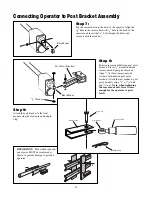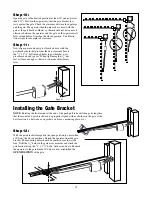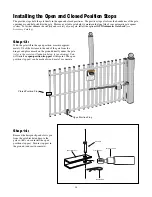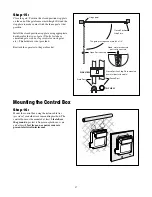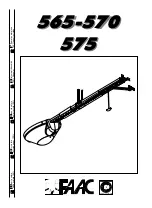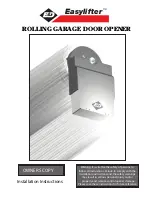
2
IMPORTANT SAFETY INSTRUCTIONS
FOR THE SYSTEM DESIGNER
WARNING: To reduce the risk of injury or death:
1.
READ AND FOLLOW ALL INSTRUCTIONS.
2.
This operator is intended for use only on vehicular gates. Pedestrians must be supplied with a separate walk-through
gate (see Entrapment Protection illustration on page 6).
3.
When designing a system that will be entered from a highway or main thoroughfare, make sure the system is placed
far enough from the road to prevent traffic congestion.
4.
The gate must be installed in a location that provides adequate clearance between it and adjacent structures when
opening and closing to reduce the risk of entrapment. Swinging gates shall not open into public access areas.
FOR THE INSTALLER
WARNING–To reduce the risk of injury or death:
I. Before Installation
1.
READ AND FOLLOW ALL INSTRUCTIONS.
2.
Verify this operator is proper for the type and size of gate, and its frequency of use.
3.
Make sure the gate has been properly installed and swings freely in both directions. Repair or replace all worn or
damaged gate hardware prior to installation. A freely moving gate will require less force to operate and will
enhance the performance of the operator and safety devices used with the system.
4.
Review the operation of the system to become familiar with its safety features. Understand how to manually open
and close the gate by disconnecting the operator (see page 1).
5.
This gate operator is intended for vehicular gates ONLY. A separate entrance or gate must be installed for pedes-
trian use (see page 6). NO ONE SHOULD CROSS THE PATH OF A MOVING GATE.
II. During Installation
1.
Install the gate operator on the inside of the property and fence line. DO NOT install an operator on the outside of
the gate where the public has access to it. Swinging gates shall not open into public access areas.
2.
Be careful with moving parts and avoid close proximity to areas where fingers or hands could be pinched.
3.
Installation of additional safety equipment such as safety edges (or photoelectric sensors) is suggested for
augmented protection against entrapment (see page 6).
4.
Determine the best obstruction sensing setting for this installation. The gate MUST stop and reverse on contact with
an obstruction or when an object activates the non-contact sensors. After adjusting the force or the limit of travel,
retest the gate operator. Failure to adjust and retest the gate operator properly can increase the risk of injury
or death.
5.
Mount access controls away from the gate (minimum distance is 10 feet). The user must have full view of the gate
but be unable to touch it while operating the controls.
6.
Secure outdoor or easily accessed gate operator controls in order to prohibit unauthorized use of the gate.

















